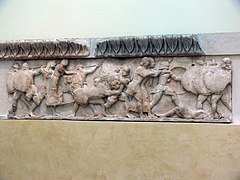Siphnian Treasury
| Siphnian Treasury | |
|---|---|

North frieze, showing the Gigantomachy
|
|
| General information | |
| Type | Treasury |
| Architectural style | Ionic |
| Location | Delphi, Greece |
| Owner | Delphi Archaeological Museum |
The Siphnian Treasury was a building at the Ancient Greek cult centre of Delphi, erected to host the offerings of the polis, or city-state, of Siphnos. It was one of a number of treasuries lining the "Sacred Way", the processional route through the Sanctuary of Apollo, erected to win the favor of the gods and increase the prestige of the donor polis. It was one of the earlier surviving buildings of this type, and its date remains a matter for debate, with the most plausible date being around 525 BC. Until recently it was often confused or conflated with the neighbouring Cnidian Treasury, a similar but less elaborate building, as the remains of the two had become mixed together and earlier theoretical reconstructions used parts of both.
The people of Siphnos had gained enormous wealth from their silver and gold mines in the Archaic period (Herodotus III.57) and used the tithe of their income to erect the treasury, the first religious structure made entirely out of marble. The building was used to house many lavish votive offerings given to the priests to be offered to Apollo.
The Treasury fell to ruins over the centuries, although it stood for much longer than many other monuments, probably due to its decoration which was venerated by the following generations. Currently, the sculpture and a reconstruction of the Treasury are to be seen in the Delphi Archaeological Museum.
The only classical source to provide information on this building is Herodotus (3:57-8). If Herodotus is to be deemed a reliable source, this would be sufficient for verifying the date. In his account Herodotus states that the Siphnians had recently founded a temple at Delphi when a group of Samians arrived asking for support against the tyrannical Polycrates. In respect to this, both Herodotus and Thucydides state that Polykrates ruled during the reign of the Persian king Kambyses (c. 529-522 BC). This would thus date the monument at about 525 BC. one source considers the date of construction as more likely some time absolutely limited to after 480 BC (Whitley).
...
Wikipedia
